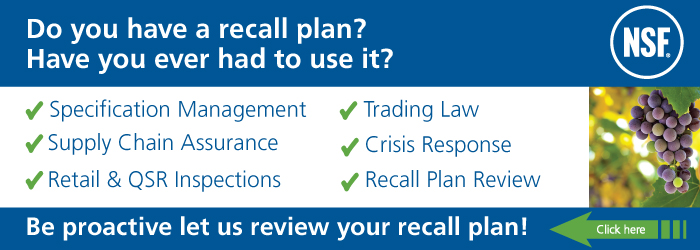The outbreak of Listeriosis resulted in the largest food recall in South Africa. All media channels were flooded with notifications of the recall after the mandatory recall notice was issued on 4 March 2018. To make matters worse, the international sweetcorn recall again bombarded food service and retail sectors alike.
We have seen that recalls like these have a ripple effect on the food chain with retailers, distributors and other customers all having to implement a recall in their respective sectors. If your company was directly affected, you would have been dusting off your recall and crisis management procedure and implementing this. Hopefully it worked for you.
If you escaped this recall, the “near miss” should have prompted you to take the opportunity to review your current procedure to ensure that it would been effective in a real crisis. If you haven’t got a procedure, then now is the time to start thinking of one – this has just become a new legal requirements for all food handling establishments under the new hygiene regulations R638.
In my experience, many recall procedures have been written to tick an audit box but in reality, they are not worth the paper they are written on. Here are some of my best tips given my many years of dealing with food recalls in South Africa.
Start with a customer complaints procedure
Every company should have a formal customer complaints procedure. The procedure should follow a logical flow and lead to escalation when a critical limited is reached or when a critical complaint is received for example a customer claiming food borne disease. It is important to note that when it comes to life threating issues - it is not a numbers game, one complaint can justify a full product recall. This procedure should clearly detail who should be notified in such a case.
Track your sources of complaints
Have you thought about where customers will lodge complaints? You should be monitoring or have monitored the following:
- Website
- Email
- Social media
- Toll free number
- Employees
- Reception/switchboard
- Manager
What is the big picture?
When you are receiving many complaints, the ability to track and review trends is critical and here you will need tools to help you:
- To capture the information from all sources – e.g. complaint management system
- To proactively use trend analysis and be also able to recognise when an incident requires escalation to a Product Recall Team
- To escalate based on the risk.

What to do when it appears serious
When an issue is escalated, the Product Recall Team should perform a preliminary risk assessment. The team should be aware of what initial actions to take and who should make the appropriate decisions. This will include ensuring that appointed personnel have the authority to inform the relevant authorities.
It is imperative that all activities and decisions are entered in the Incident Log. The Incident Log will greatly assist the Product Recall Team to carry out the risk assessment process in order to determine if a product recall is required
- all information should be documented (date, time, provider of information)
- sign-off is recorded by Product Recall Team member
- details of all activities that are required to be carried out
Having a consistent way of recording the information provides a method to review information and this would serve as a legal document, should the need arise.
To recall or not to recall?
The Product recall team should use the following to determine if a recall is necessary:
- Level of public safety risk or damage to brand reputation
- Credibility of incident information
- Verify the problem and product(s) concerned – the extent of the problem or potential problem
- Investigations to establish possible causes of problem
- Start the process of Evidence gathering:
- External (suppliers, distributors, regulatory authorities, social media)
- Internal (complaint history, compliance data, QA, production, distribution and storage data, interview with employees)
NB: All these activities should happen simultaneously to enable the company to react in the quickest possible time – remember lives may be at risk. This is a critical activity and must be treated as such!
The cost of a recall
When considering what the budget is make sure you account for the costs to
- Retrieve the products
- Logistic costs
- Advertising costs
- Cost of personnel
- Destroy the products
- Produce replacing products
- Repair damage to brand
- Loss of contracts
- Loss of profit
You should have insurance in place for this scenario and your insurance company must be involved in the recall process. Remember the cost of the recall is far less than the potential damage to your brand.
Your recall policy and procedure
If something is important, it should be written down and the same applies to your recall policy and procedure. The Product Recall Policy is an essential part of the food safety management system and should be developed and agreed before the Product Recall plan is even implemented. This demonstrates Senior Management’s commitment to protect public health and to provide resources to effectively manage a product recall. Putting the consumer’s health first is always the right thing to do.




